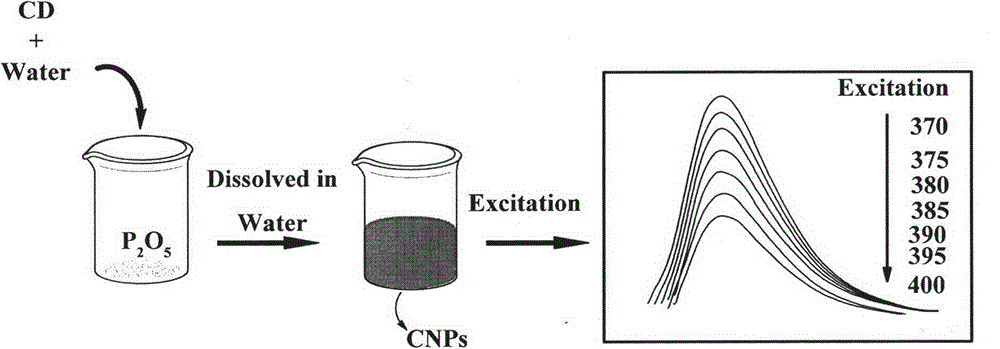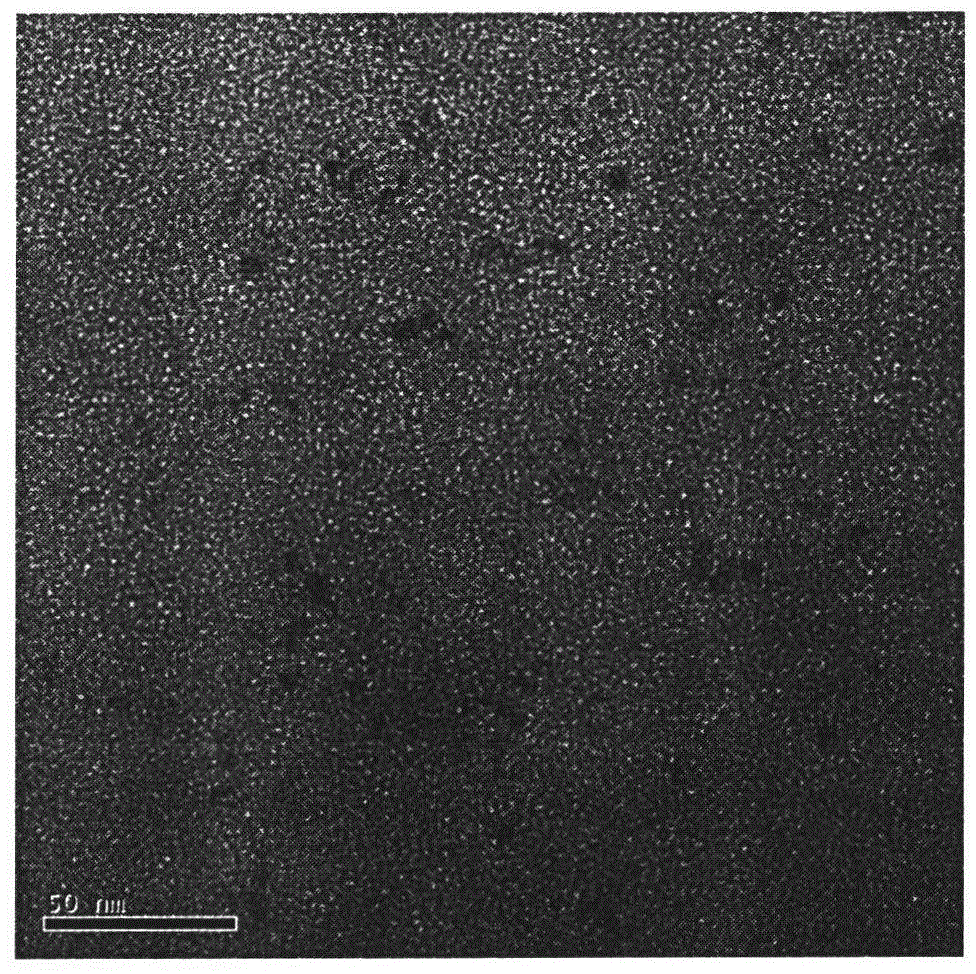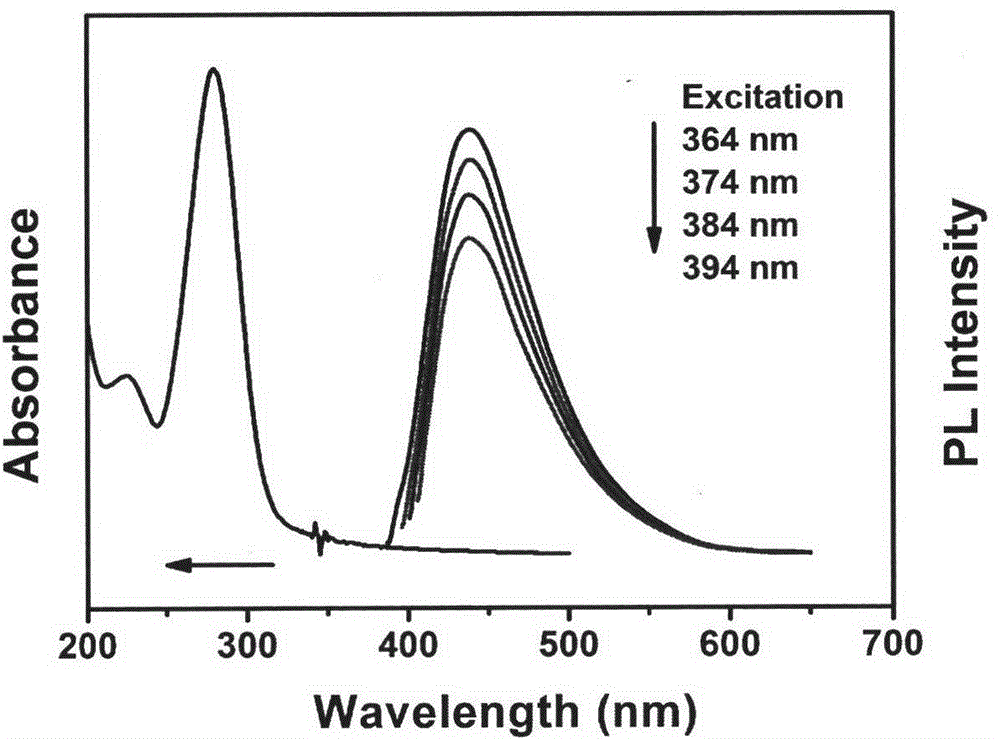Method for preparing fluorescent carbon nanoparticles by spontaneous reaction
A technology of carbon nanoparticles and fluorescence, which is applied in the direction of luminescent materials, nanotechnology, fluorescence/phosphorescence, etc., can solve the problems of cumbersome operation, low yield, unstable fluorescence emission wavelength, etc., and achieve broad application prospects, low cost, and excellent quality The effect of optical properties
- Summary
- Abstract
- Description
- Claims
- Application Information
AI Technical Summary
Problems solved by technology
Method used
Image
Examples
example 1
[0026] The preparation of fluorescent carbon nanoparticles of the present invention is as follows:
[0027] (1) Preparation of cyclodextrin aqueous solution: Weigh 0.2g of β-CD into a 5mL EP tube, add 2mL of distilled water into the EP tube with a pipette gun, and disperse it by ultrasonication;
[0028] (2) Preparation of fluorescent carbon nanoparticles: Weigh 2.5g P 2 o 5 In a 50mL Erlenmeyer flask, shake it so that it spreads flat on the bottom of the flask; to increase the P 2 o 5 The area in contact with the β-CD solution is sufficient to make the reaction fully; quickly pour the β-CD aqueous solution in the EP tube obtained in step (1) into the Erlenmeyer flask, an exothermic reaction occurs, white mist is generated, and the bottom of the bottle becomes brown-black Viscous liquid, the mixture gradually cooled to room temperature after 10 min;
[0029] (3) Centrifugal separation of fluorescent carbon nanoparticles: add 10 mL of distilled water to the Erlenmeyer flask...
example 2
[0032] (1) Preparation of cyclodextrin aqueous solution: Weigh 0.4g α-CD into a 5mL EP tube, add 4mL distilled water into the EP tube with a pipette gun, and disperse it by ultrasonic;
[0033] (2) Preparation of fluorescent carbon nanoparticles: Weigh 4.0g P 2 o 5 In a 50mL Erlenmeyer flask, shake it so that it spreads flat on the bottom of the flask; to increase the P 2 o 5 Contact area with α-CD solution to make the reaction fully; quickly pour the β-CD aqueous solution in the EP tube obtained in step (1) into the Erlenmeyer flask, an exothermic reaction occurs, white mist is generated, and the bottom of the bottle becomes brown-black Viscous liquid, the mixture gradually cooled to room temperature after 10 min;
[0034] (3) Centrifugal separation of fluorescent carbon nanoparticles: add 20mL of distilled water to the Erlenmeyer flask in step (2), shake and mix, add the mixed solution to 12 2mL EP tubes with a pipette gun; put the EP tube after adding the liquid Put it ...
example 3
[0039] After co-incubating the fluorescent carbon nanoparticles obtained in Example 1 with polyethylene glycol and co-incubating with human breast cancer MCF-7 cells, the fluorescence of the cell membrane and cytoplasm of MCF-7 cells was observed by two-photon fluorescence microscopy. Most obviously, it is speculated that the carbon nanoparticles can be transported to the interior of the cell through endocytosis, and can be used as bioluminescent probes for in vitro cell imaging; in addition, carbon nanoparticles bonded to membrane translocation peptides such as HIV-1 trans On the transcriptional activator (TAT), carbon nanoparticles can be well imaged in the nucleus.
PUM
| Property | Measurement | Unit |
|---|---|---|
| diameter | aaaaa | aaaaa |
| particle diameter | aaaaa | aaaaa |
| particle diameter | aaaaa | aaaaa |
Abstract
Description
Claims
Application Information
 Login to View More
Login to View More - R&D
- Intellectual Property
- Life Sciences
- Materials
- Tech Scout
- Unparalleled Data Quality
- Higher Quality Content
- 60% Fewer Hallucinations
Browse by: Latest US Patents, China's latest patents, Technical Efficacy Thesaurus, Application Domain, Technology Topic, Popular Technical Reports.
© 2025 PatSnap. All rights reserved.Legal|Privacy policy|Modern Slavery Act Transparency Statement|Sitemap|About US| Contact US: help@patsnap.com



